We walk like pilgrims, heads bowed, following in the footsteps of the man in front across the snow, some with walking sticks, others carrying heavy packs, all with the steadfast belief that we are damn well going to get a photo of ourselves on the Troll’s Tongue doing a star jump. The Trolltunga, as it’s known in Norwegian, is a spit of rock jutting out from a sheer face, about 700m above Ringedal lake in the Hardangerfjord region of south-west Norway, and the photo has become a tourist must-do over the past few years. It’s not the simplest of snaps to bag though: it involves a 22km circular hike from the starting point at the activity centre down in the valley at Skjeggedal.
The Guardian’s product and service reviews are independent and are in no way influenced by any advertiser or commercial initiative. We will earn a commission from the retailer if you buy something through an affiliate link. Learn more.
This is my third hike in as many days, and I can feel my leg muscles protesting – a rest day might have been a good idea. But touring the “Big Three” of western Norway – Kjerag, Preikestolen (Pulpit Rock) and Trolltunga – is irresistible. The wonderful scenery combined with dramatic rock formations at each location make these three among the most popular trails in the country, plus the photo ops and bragability factor of standing out on these seemingly precarious rocks is a great draw. The fjord region in particular gets most footfall because of the excellent infrastructure, with well-marked paths and cabins for overnight stays.
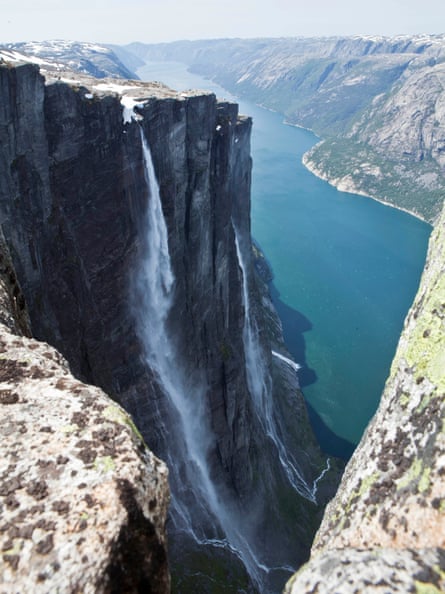
And now an express bus route has linked these three hikes. Previously they were only reachable by car, but the bus – with tickets from 490 NOK (£39, bookable at tide.no, no cash taken on the buses) – makes this notoriously expensive country much more accessible. Plus there’s budget accommodation at each stop, so the whole five-day trip costs me under £500, including flights and breakfasts. Packed lunches can be made from the breakfast spread for a small fee at most huts and hotels, and £15 is about the average cost of an evening meal. Alcohol is still a sticking point – if you want to do Norway cheaply, go teetotal, or decant a bottle of duty-free hooch into a plastic trekking bottle.
The bus runs through the summer season. In the Stavanger region, where Kjerag and Preikestolen are found, it runs from June to the end of August and to Trolltunga in the Hardanger region, from July to August. I visit as soon as the bus route to Trolltunga opens at the beginning of July.
The snow should have disappeared a month ago, but it has been a long winter, and our small guided group, booked through Trolltunga Active (eight-hour guided walk £43pp, trolltunga-active.com), has to negotiate the snowy path quite slowly. We reach our destination after five-and-a-half hours, shovelling down our packed lunches while taking in the views across the fjord. It’s a gloriously sunny day, and the mainly young crowd creates something akin to a festival atmosphere while we queue to get “that shot” on the tongue.
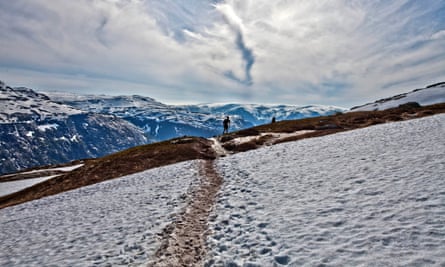
When I peer breathlessly over the precipice, Daniel, our guide, tells me: “These hikes provide some of the most spectacular views of Norway’s natural wonders. They are not just sightseeing trips, but real challenges. You feel like you have really earned the thrill of standing on the edge.”
My trip had begun three days earlier in the pretty harbour town of Stavanger, where I stayed the night before making the three-hour bus journey to Øygardstøl, for the first hike to Kjerag boulder, a tough five-hour walk including an ascent of a sheer rock face using metal rungs that ended in a gale force wind hitting me like a smack in the face on the cliff top. Sunglasses, hats, loose clothing and anything that isn’t fastened down is whipped off and flung over the side of the cliff, as if some mischievous invisible troll is having fun.
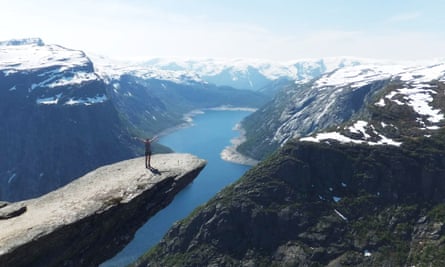
Without the late snow, the Kjerag boulder can be enjoyed in its full-suspended glory, wedged miraculously between two cliff faces, for the more intrepid to walk out on to. But with the buffeting wind and snowy conditions, I thought better of it and enjoyed instead the spectacular waterfall, mighty with snowmelt, cascading into Lysefjord, 1,000m below.
I celebrated afterwards with a beer at the Øygardstø hut at the bottom but, because it’s not possible to stay overnight here, I took a (free) shuttle bus down to the Lysebotn mountain accommodation on the fjord shore. These cabins are part of an impressive network of more than 500 across the country, run by the Norwegian Trekking Association, and consist of small, neat chalet blocks around a common room and dining area. A dorm bed costs £25 a night, including breakfast. At dinner, I sat on the small veranda to watch the sun not set, with my warming bowl of “hippie” vegan stew and chatted to hikers from as far afield as Malaysia and the US, all here for the natural wonders.

A ferry takes hikers to the next challenge, through the dramatic Lysefjord, to Forsand, where a bus (£22 return) runs up to the Preikestolen mountain hut for the starting point of the second trail. This hut couldn’t be less of a “hut”. It is a magnificent Scandi-modern building, with hotel-standard rooms, fjord views and dorm beds again for £25. Meals are served on giant slate tables in front of the hut and feature five courses of dishes such as tomato soup with egg, poached salmon, pork neck and salads, then home-baked cakes.
The second walk, from here to Pulpit Rock, is by far the easiest of the three, with toddlers and elderly people among those enjoying the two-hour trek up to a large flat shelf of granite projecting out over the fjord.
We are lower here (604m) than at Kjerag so the snow is not a problem, in fact, there are large freshwater pools connected by streams that are warm enough to swim in at this time of year, and I happily plunge in for a cooling dip on my way back down.
It was then a five-hour bus ride up to Odda for the Trolltunga hike, but the journey flew by while I gawped at a landscape peppered with spectacular waterfalls, which has earned this route the moniker of “most beautiful bus route in Norway”.
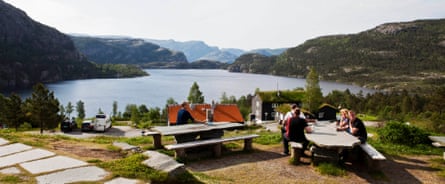
The basic Trolltunga Hotel was my base in Odda, convenient for the shuttle service ferrying hikers up to the start of the trail in the morning. Such organisation and reliable services make a short hiking trip to revel in the majesty of the three “rock stars” of Norway so easy ... the only thing to worry about is the aching muscles at the end of it.
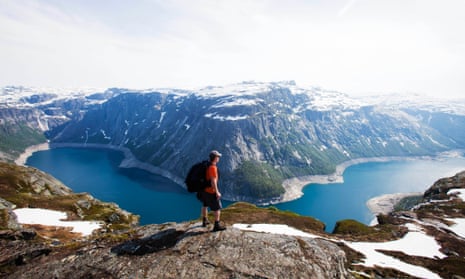
Comments (…)
Sign in or create your Guardian account to join the discussion